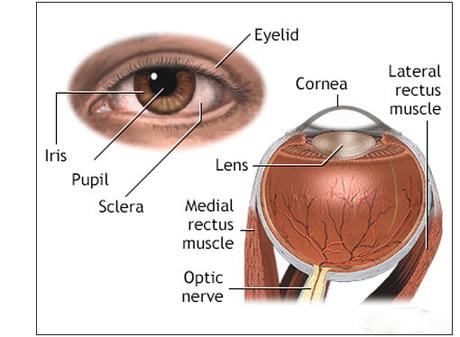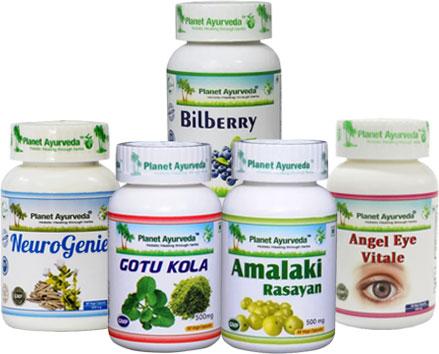Abstract
Optic neuritis (ON), which is primarily idiopathic, is characterised by inflammation of the optic nerve. An optic nerve is a collection of nerve fibres that transmits visual data from the eye to the brain. When the optic nerve becomes inflamed and swollen, optic neuritis results. The purpose of this study is to provide an overview of the most recent data on optic neuritis, its differential diagnosis, and its treatment. This study aims to compile the most recent data on optic neuritis, its differential diagnosis, and treatment.

Introduction
Optic neuritis (ON) is the most prevalent form of optic neuropathy in patients under the age of 50 who visit a general ophthalmologist. It is characterised by subacute unilateral painful visual loss that is typically present in young, healthy females and excludes glaucoma. On the basis of the genesis of the disease, optic neuritis is broadly classified as typical or atypical. While atypical optic neuritis is unrelated to multiple sclerosis (MS), normal optic neuritis is highly connected with MS. The genesis, pathophysiology, and treatments of the two types vary. A correct differential diagnosis is essential to effective clinical therapy. A new optic neuritis episode as well as the first occurrence or relapse of existing MS may be prevented or delayed by disease-modifying medications.
Causes
The exact cause of ON is unknown. It is thought to start when your immune system accidentally attacks the material that covers your optic nerve, causing inflammation and myelin damage. Normal myelin function speeds up the transmission of electrical impulses from the eye to the brain, where they are translated into visual information. Optic neuritis interferes with this mechanism, impairing vision.
Some autoimmune conditions are also responsible for optic neuritis.
In people with multiple sclerosis, the autoimmune system attacks the myelin covering that shields the nerve fibres in their brain. One bout of optic neuritis increases a person's lifetime risk of developing multiple sclerosis by 50%.
- Myelin oligodendrocyte glycoprotein (MOG) antibody disorder
The spinal cord, brain, and optic nerve may all become inflamed as a result of this illness. Recurrent episodes of inflammation can happen, much like in MS and neuromyelitis optica. Attacks on the myelin oligodendrocyte glycoprotein (MOG) typically lead to better recovery than neuromyelitis Optica.
Associated Problems
Optic neuritis can be caused by bacterial conditions including Lyme disease, cat scratch fever, and syphilis, as well as viruses like measles, mumps, and herpes.
Recurrent optic neuritis can result from a number of illnesses, including lupus, Behcet's disease, and sarcoidosis.
Some drugs and chemicals have been related to ocular neuritis, like ethambutol and methanol.
Symptoms Of Optic Neuritis
Optic neuritis generally affects one eye. Symptoms are as follows
The majority of patients with optic neuritis experience eye pain that gets worse with eye movement. Behind the eye, pain might occasionally feel like a dull ache.
- Loss of vision in one eye
The majority of people experience transient vision loss, but to varying degrees. Visible vision loss typically starts over a few hours or days and becomes better over the course of a few weeks or months. Some may experience irreversible vision loss.
Any pattern of side vision loss, such as central vision loss or peripheral vision loss, is possible.
Colour perception is often impacted by optic neuritis. You could notice that colours don't seem as bright as they usually do.
Some optic neuritis sufferers claim to experience flashing or flickering lights when moving their eyes.
Diagnosis
- Regular vision testing
- Ophthalmoscopy
- A visual field test
- A visual-evoked response test
- A blood test
- An optical coherence tomography scan
- A pupillary light reaction test
- Magnetic resonance imaging
Management
Whether or not treatment is initiated, visual function will gradually return to levels that are close to normal over the course of a few weeks to months.
Other medications
- Intravenous methylprednisolone
- Oral prednisone
Risk Factors
- Age : Adults aged 20 to 40 are most frequently affected by optic neuritis.
- Sex : Optic neuritis is substantially more common in women than in men.
- Race : In Caucasian people, optic neuritis occurs more frequently.
- Genetic changes : The chances of getting optic neuritis or multiple sclerosis may rise as a result of specific genetic alterations. </li
.
Complications
- Optic nerve damage.
- Decreased visual acuity.
- Side effects of treatment.
Ayurvedic View
In Ayurvedic Ophthalmology, Optic Neuritis symptoms are usually seen in cases of Vataja Timir, which affects the first and second patala of the eye, Vata viparya, and Anyota Vata. The most often occurring causes of vata vitiation are Dhatu Kshaya and Vegadharan. The degradation of the nerves and other ocular components becomes apparent at this point. Extreme physical and mental stress is another factor that coexists with Vata Prakopa.
Management
- Yapana Basti (specific type of medicated anema)
- Virechan (medicated purgations)
- Nasya are the purification procedures (medicated nasal drops)
- Netra Tarpan (procedure for rehydration of the eyes)
- Aschyotan (instillation of the drug in the form of drops into the eyes)
- Putapaka (lukewarm medicated juice (swarasa) prepared with the help of putapaka vidhi is made to stay stagnant in the eyes for a speculated time with the help of a prepared frame)
- Pariseka (steaming of the eyes)
- Pindi (packing medicines or medicated pastes in a thick cotton cloth and keeping them tightly over the eyelids)
- Vidalaka (medicated herbal paste applied over the eyelids, leaving eyelashes for a prescribed time at a prescribed thickness)
These are only a few of the ocular therapies that are quite effective in restoring vision.
Herbal Remedies For Optic Neuritis By Planet Ayurveda
The well-known Ayurvedic Company Planet Ayurveda is US-FDA registered, GMP-approved, and ISO 9001:2015 certified. It produces the typical ayurvedic medicines mentioned in the classic ayurvedic literature. The medications are created without any preservatives or ingredients that might harm someone's health. Products that are made are unadulterated because they are pure. Optic neuritis has been successfully treated using a number of ayurvedic formulations created by Planet Ayurveda that are safe and effective.


Product List
- Gotu Kola Capsules
- Neurogenie Capsules
- Amalaki Rasaya
- Bilberry Capsules
- Angel Eye Vitale
Product Description
1. Gotukola Capsules
Centella asiatica (also known as gotu kola) is used in the formulation of Planet Ayurveda's gotu kola capsules, which are single herbal capsules. It might help with the treatment of dry eyes by opening up the pathways to the eyes and promoting the generation of more tears. Gotu kola may help prevent eyesight loss by promoting the generation of rhodopsin in the retina. It helps with anxiety and despair. It alleviates fear and hopelessness. It treats burns and wounds while maintaining a healthy blood flow. The blood circulation has improved. It helps with both sleeplessness and mental impairment. It benefits the treatment of aging-related mental diseases in older people and helps maintain mental clarity.
Dosage : Two capsules, twice daily.
2. Neurogenie Capsules
Planet Ayurveda created the multi-herbal formulations known as Neurogenie capsules using standardised extracts of Brahmi (Bacopa monnieri) and Ashwagandha (Withania somnifera) . The brain and nervous system benefit from the tonic qualities of ashwagandha. Ashwagandha increases stamina and strength while protecting against all types of weakness. The outcome is stronger muscles. Brahmi has antioxidant properties as well as the ability to enhance focus, memory, and learning. To treat the vitiated vata dosha, which governs the neurological system, it is a preferred drug. Brahmi increases the capacity of the mind to concentrate and learn.
Dosage : Two capsules, twice daily.
3. Amalaki Rasayan
Planet Ayurveda created Amalaki rasayan, a single herbal capsule using Emblica officinalis (Amalaki). Vitamin C is abundant in amla and is beneficial for treating eye conditions. The ocular muscles are strengthened, and the eyes are nourished. A cooling and calming effect is provided by amalaki. It facilitates tridoshas' tranquilization and intensifies pitta dosha's work. In addition to having analgesic and anti-inflammatory effects, it has a wealth of natural antioxidants.
Dosage : Two capsules, twice daily.
4. Bilberry Capsules
Single herbal capsules called "bilberry capsules" are made by Planet Ayurveda using a standardised bilberry (Vaccinium myrtillus) extract. Bilberry may help avoid retinal damage. Eye floaters may be lessened or even eliminated by bilberry. Bilberries may reduce intraocular pressure in those with controlled primary open-angle glaucoma. Dry eyes may benefit from bilberries. Bilberries may help with this exceedingly unique ailment of the light-sensitive.
Dosage : One capsule, twice daily.
5. Angel Eye Vitale
Planet Ayurveda created the multi-herbal compound known as Angel Eye Vitale with the use of extracts from the plants Emblica officinalis (Amla), Centella asiatica (Gotu kola), and Eclipta alba (Bhringraj). Eye illnesses and other related problems can benefit from it. Therapy for eye strain may benefit from it. Amalaki strengthens the ocular muscles and nourishes the eyes. Regarding vision problems and other eye diseases, Bhringraj may be helpful. Gotu kola may assist in preventing eyesight loss.
Dosage : One capsule, twice a day.
Contact Planet Ayurveda Support Team to provide you the costing/ordering and delivery information at - [email protected] or Call at 0172-521-4040 (India), +91-172-521-4040 (Outside India) or Whatsapp at (+91) 842-749-4030.
Optic neuritis (ON) is the most prevalent form of optic neuropathy. Typically prevalent in young, healthy females, it is characterised by subacute, unilateral, painful vision loss. This study's objective is to present a summary of the most recent information on optic neuritis, its differential diagnoses, and its therapies. The objective of this study is to assemble the most recent information on optic neuritis, its differential diagnoses, and therapies.

